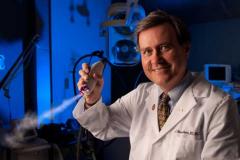Lighting the Way
 The concept that revolutionized laser surgery and earned UC Irvine more than $40 million came to Dr. J. Stuart Nelson in 1992 while he was watching a baseball game.
The concept that revolutionized laser surgery and earned UC Irvine more than $40 million came to Dr. J. Stuart Nelson in 1992 while he was watching a baseball game.
In the early 1990s, surgeons like Nelson were trying to adapt laser technology for medical use, and the Beckman Laser Institute & Medical Clinic was an epicenter for this effort. It was, at the time, the only facility in the world to house basic science and engineering labs and an outpatient clinic under one roof, letting researchers and surgeons quickly translate findings into patient-care breakthroughs.
 As medical director of the BLIMC, Nelson had been striving to improve laser treatments for disfiguring vascular birthmarks, such as port-wine stains, in infants and young children. Laser’s utility was limited because its intense light also injured the fragile top layer of skin, causing pain, scarring and pigmentation changes. The challenge was to find a way to protect the outer skin while maximizing destruction of the deeper blood vessels that create a birthmark.
As medical director of the BLIMC, Nelson had been striving to improve laser treatments for disfiguring vascular birthmarks, such as port-wine stains, in infants and young children. Laser’s utility was limited because its intense light also injured the fragile top layer of skin, causing pain, scarring and pigmentation changes. The challenge was to find a way to protect the outer skin while maximizing destruction of the deeper blood vessels that create a birthmark.
Nelson and his BLIMC colleagues – postdoctoral researcher Thomas Milner and visiting Norwegian engineer Lars Svaasand – had tried using ice cubes, running cold water and even the application of chilled metal plates to cool the skin’s superficial layer before laser exposure. Unfortunately, all of these methods proved too cumbersome and, more importantly, also cooled the targeted blood vessels, which inhibited the laser’s effectiveness.
Read More >>
